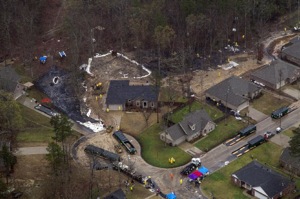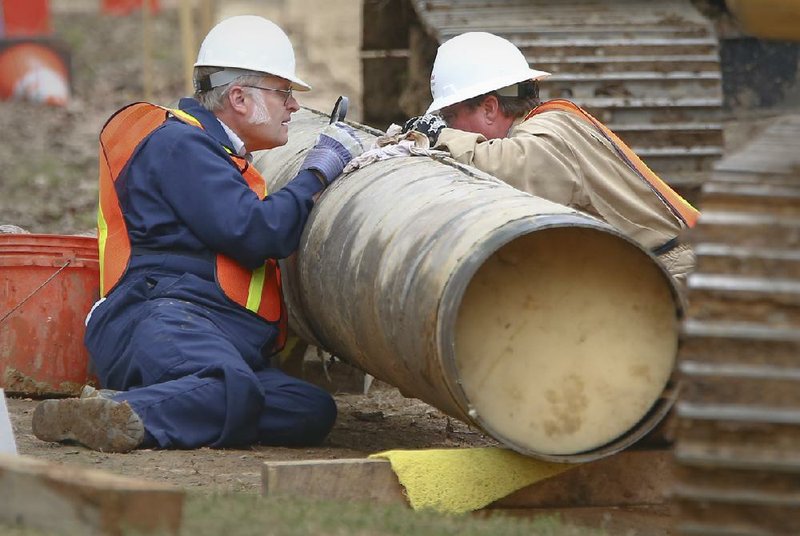Manufacturing defects, blamed for a March 29 pipeline rupture in Mayflower, also accounted for a total of 12 seam failures in the same crude-oil pipeline during a series of pressure tests Exxon Mobil commissioned shortly before it restarted the long-idle carrier in February 2006, documents show.

All those failures along the Pegasus pipeline occurred on welded seams of the steel pipeline, most of which was built in 1947-48, according to test results released recently by the federal Pipeline and Hazardous Materials Safety Administration and reviewed by the Arkansas Democrat-Gazette. All the failures led to repairs, according a report on the tests that runs more than 160 pages.
“I am greatly concerned and troubled by the 2005-06 hydrostatic-test results from the Pegasus pipeline that detected numerous incidences of manufacturing defects and seam failures,” U.S. Rep. Tim Griffin said Wednesday. “I have requested an in-depth briefing on this issue, and I am continuing my investigation. I am committed to ensuring the victims of this spill are made whole and the drinking water for more than 400,000 Arkansans remains safe.”
The pipeline administration, also known by its initials PHMSA, has concerns as well.
“PHMSA’s ongoing investigation includes looking at the point of failure as well as the entire Pegasus Pipeline,” spokesman Patricia Klinger said in an email. “The pipeline will remain shut down until PHMSA is convinced it can be restarted safely.” The agency also is looking at the pipeline’s history, she said.
Further, a corrective order affirmed by that agency in May cited “uncertainty as to the current seam integrity on the entire Pegasus Pipeline.”
Griff in, a Republican whose 2nd District includes Mayflower, had pressed the pipeline administration to release the hydrostatic-test report and other documents.
He and others are especially concerned about Lake Maumelle, the drinking-water source for more than 400,000 central Arkansans. About 13.5 miles of the pipeline run beneath the lake’s watershed.
The hydrostatic tests, conducted in sections for Exxon Mobil Pipeline Co., found no problems in the Mayflower segment, according to the report. Two of the 12 seam failures, however, occurred in a nearby section of the pipeline, also considered under the company’s Conway station. Those two failures occurred at mileposts 298.1 and 294.1 during tests in late January 2006 of Conway Test Section 15, which covered 15.76 miles.
The Mayflower rupture took place at milepost 314.77 and spilled an estimated 210,000 gallons of heavy crude oil into the Northwoods subdivision, an unnamed creek and a cove that is part of Lake Conway.
In an April 14, 2006, memorandum filed with the federal agency, Chris Gorman, the company’s pipeline risk and integrity specialist, wrote that an analysis of the broken steel-pipe sections in Conway Test Section 15 indicated “the failures were caused by original mill [factory] defects in the long seam that failed at, or slightly less than, the 1991 test pressures at each site.”
“No fatigue, selective corrosion, or other dependant defects were observed,” Gorman added. “However, the results also suggest that the seam toughness was probably reduced by the effects of the [February] 2006 test water temperature … being much lower than the August 1991 temperatures.”
A second document within the hydrostatic-test report said that “test breaks in the ERW [electric resistance weld] seam … were replaced with new pipe.” Tests were repeated on Feb. 1 without leaks or ruptures, the report said.
Such seams are longitudinally welded. The hazards of such pre-1970 welding have been known for years in the pipeline industry.
“A failure in the weld seam of this type of pipe can propagate for a distance along the pipe and can quickly release large quantities” of oil, according to the pipeline administration’s website.
The Pegasus pipeline, which carries thick Canadian crude about 850 miles from Illinois to the Texas Gulf Coast, was shut down between 2002 and 2006.
“That’s why we had to do hydrotesting” before it reopened, Exxon Mobil Corp. spokesman Aaron Stryk said in an email.
According to the pipeline administration’s website, new pipeline systems or segments must be hydrostatically pressure-tested to 1.25 times the maximum allowable operating pressure before a pipeline is placed into service.
The 2005-06 hydrostatic testing is the most recent such test conducted on the Pegasus pipeline, though there have been other kinds of in-line inspections - the most recent being conducted in February. Griffin said he will release any results already available from that inspection if the pipeline agency does not do so.
Stryk said much of the Pegasus pipeline was built by a long-defunct Youngstown, Ohio, business but that the line also contains seamless pipe from another manufacturer.
In the seamed part of the pipeline, the seams run longitudinally except for “girth welds that connect the segments,” Stryk said.
Asked whether the hydrostatic failures suggested even more testing was needed before the pipeline resumed service in 2006, Stryk declined to comment “because the investigation is still ongoing.”
“Our comprehensive efforts to review and understand how and why the Pegasus pipeline failed when it did will be instrumental to provide actionable recommendations for assessing, improving and sustaining an integrity program for Pegasus and other pipelines. Due to the complexity of the issue, it is inappropriate to speculate or try to draw conclusions from the hydrotest alone,” he added.
Other hydrostatic-related problems discovered in the 2005-06 series of hydrostatic tests:
Four failures in a 42.75-mile stretch under the company’s Oakdale, Ill., station. “Results of the analysis indicated all to be caused by original factory/mill defects that failed after being tested to higher pressures than they had ever seen before,” Gorman wrote in a memorandum dated March 17, 2006.
“There were two pin hole leaks in girth welds found during testing,” Gorman wrote. “Cause of the pin holes were inadequate penetration of the weld bead at the 6:00o’clock position where the two weld passes overlapped creating an internal pocket where corrosive elements could accumulate. Both were repaired in place with a permanent weld sleeve.”
No “selective corrosion” was found, Gorman said. .
One failure on Dec. 2, 2005, blamed on original factory or mill defects in a 33.54-mile test section under the Cherokee Pass, Mo., station. The company reported finding “one pin hole leak in a girth weld.”
One failure on Dec. 19, 2005, in a test section under the Doniphan, Mo., station.An analysis indicated this problem was caused by manufacturing defects “and damage during construction.”
Two Arkansas failures - one on Feb. 7, 2006, and one on Feb. 17, 2006 - in a Glenwood section that covered 19.25 miles. A metallurgical analysis blamed “original mill defects in the long seam,” Gorman wrote in an April 14, 2006, memorandum. Both sections of defective pipe were replaced with new pipe, a separate document in the report said.
Two more state failures on Feb. 13, 2006, in a Foreman-station section that covered 34.07 miles. In addition to original defects, Gorman said, an analysis also suggested “that the seam toughness was probably reduced by the effects” of the water temperature being much lower than it was in August 1991.
Other findings in the report included:
A pressure loss in another Foreman-controlled section, where workers found a leaking 2-inch fitting near a block valve.
A drop in pressure during testing in a section under the Corsicana, Texas, station led to the replacement of a check valve gasket.
In affirming a corrective order issued for Exxon Mobil in May, the pipeline administration wrote, “Over time, the welds of low-frequency ERW pipe have been found to be susceptible to selective seam corrosion, hook cracks, and inadequate bonding of the seams.”
Further, the administration said its Office of Pipeline Safety had “raised some question as to the adequacy of [Exxon Mobil’s] procedures for assessing seam integrity across the Pegasus Pipeline. … For example, in-line inspections performed on the Northern Section in 2010 did not identify an anomaly at the location of the failure” in Mayflower.
At the time of the May order, a cause of the Mayflower failure had not been determined. Later, however, the company said manufacturing defects - specifically hook cracks - were in part to blame for the Mayflower rupture.
Richard Kuprewicz, who advises government agencies as well as some businesses and others on pipeline safety, said that if the pipeline passed the hydrotest, “then there’s no problem in starting the line back up.”
How often hydrotesting is done depends on the pipeline, he said.
“Hydrotesting isn’t forever” he said.
Front Section, Pages 1 on 08/08/2013
